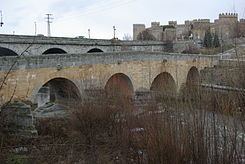Body of water Adaja river | ||
 | ||
The Roman bridge of Ávila (in Spanish: Puente Romano de Ávila) is a bridge located in the city of Ávila, in Castile and León, Spain. Portion of the bridge are Roman, located on the Adaja River, opposite the Puerta de San Segundo City Gate. The city provide of this bridge on the Adaja River, which connected the Western's porta decumana with the bank.
The piers with starling are Romans built in early-1st century D.C., the rest of the bridge is Romanesque (11th and 13th centuries).
Description
It consists of five arches and four piers with starling, bow of boat shaped projection against the rising of the stream, Roman style, projecting spurs in the piers to contrary side to the sterling, preserving the west side abutment. The top of the bridge (road) is horizontal in the eastern half presenting the other half falling to west. The arches start from different height reaching its top at the same elevation, except the more amplitude, entirely remade, it appears lower.
Apparently the bridge was disabled, on an unspecified date, totally destroying the biggest arch and cut the rest, tears still clearly visible today. In this sense the more possible was that the disablement of the bridge had taken place in the same period of the Arab invasion to 711, it is also possible that the semidestruction of the bridge would have happened at any time of the Reconquista when, coming the swollen river , any Arab or Christian army would have believed necessary to get rid of their pursuers or cut off their retreat.
At the time of the Ávila's repopulation (11th century) on the granite Roman pillars, it was rebuild the bridge with sandstone from La Colilla, widely used in the Romanesque churches in Ávila, but little resistance to wear this stone it should require, to the 13th century a new repair was made, whose remains are probably the granitic rocks of the upper topped with a rounded parapet to the Santi Espiritu and Romanillos bridges's style, built on the Chico River.
